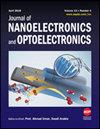Thermodynamic Analyses of the Two-Step Method of CsPbBr3 Crystal Growth for Inorganic Perovskite Solar Cells
IF 0.6
4区 工程技术
Q4 ENGINEERING, ELECTRICAL & ELECTRONIC
引用次数: 0
Abstract
We conducted integrated thermodynamic analyses for the two-step method of CsPbBr3 growth. Deriving from Gibbs free energy and heterogeneous nucleation theory, a thermodynamic reaction model equation was proposed and verified, from which we could find that the grainsizes of the CsPbBr3 can be precisely controlled by the CsBr concentration. The impact of temperature of the solvent was also studied. Finally, a best cell was fabricated showing a power conversion efficiency of 4.75%, with open circuit voltage of 1.13 V, short circuit current of 6.68 mA/cm2 and fill factor of 63%. Our results will help other researchers to determine the appropriate condition of the growth of CsPbBr3 by the two-step method.无机钙钛矿太阳能电池CsPbBr3晶体生长两步法的热力学分析
我们对CsPbBr3的两步法生长进行了综合热力学分析。从吉布斯自由能和非均相成核理论出发,提出了CsPbBr3的热力学反应模型方程,并进行了验证,发现CsPbBr3的晶粒尺寸可以由CsBr的浓度精确控制。研究了溶剂温度的影响。最终制备出最佳电池,其功率转换效率为4.75%,开路电压为1.13 V,短路电流为6.68 mA/cm2,填充系数为63%。我们的结果将有助于其他研究者通过两步法确定CsPbBr3的适宜生长条件。
本文章由计算机程序翻译,如有差异,请以英文原文为准。
求助全文
约1分钟内获得全文
求助全文
来源期刊

Journal of Nanoelectronics and Optoelectronics
工程技术-工程:电子与电气
自引率
16.70%
发文量
48
审稿时长
12.5 months
 求助内容:
求助内容: 应助结果提醒方式:
应助结果提醒方式:


